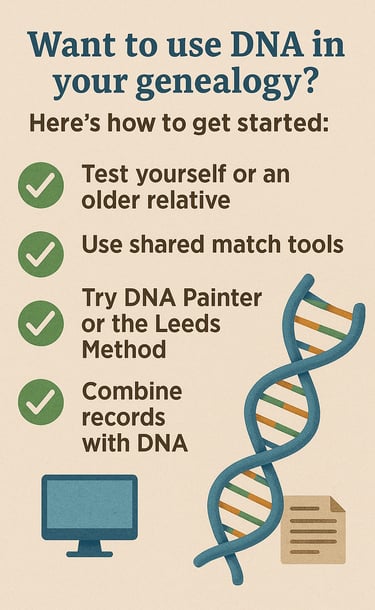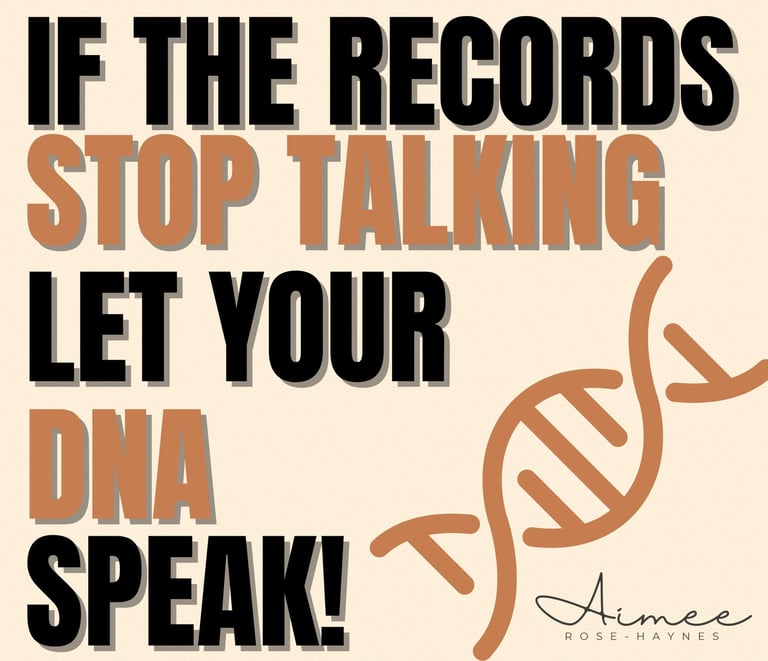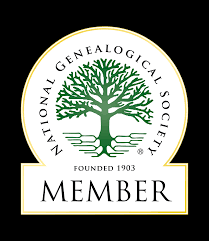Digging Deeper: When the Paper Trail Ends, Let DNA Lead the Way
When old records go silent and the paper trail runs dry, there’s one storyteller that never forgets... your DNA!
-Aimee Rose-Haynes
6/18/20253 min read


Every family tree has a few missing branches. It might be the great-grandfather who shows up in a census record and then disappears without a trace, or the ancestor whose parents are never named in any document. Maybe it is the grandmother who always whispered that her mother was Native American, but no one could ever prove it. These are the moments every genealogist knows well, when the records go silent and the trail turns cold.
For many years, that silence meant the end of the search. If no church records, courthouse documents, or headstones could be found, we simply had to accept the gap and move on. But today, we have another tool. It is not stored in dusty archives or written in cursive on aging paper. It is in us. It is in our DNA.
Genetic genealogy has opened a new path through the forest of family history. It gives us a way to confirm connections, identify biological relatives, and test the stories passed down through generations. It is not a replacement for traditional research, but it is a powerful partner. Together, DNA and documentation can tell a story that neither could tell on their own.
One of the most powerful things DNA testing can do is break down brick walls. I have seen it firsthand. A woman who was adopted at birth found her maternal grandmother through shared matches and built a connection with the family she never knew. A man who always believed he was part Choctaw confirmed his family’s story and used the evidence to enroll his children in the tribe. In another case, a family that had always honored a relative as their grandfather discovered through DNA that he was actually their great-uncle. The truth was might be painful; it was also enlightening. It gave them a clearer picture of who they were and where they came from.
If you are just getting started, or even if you have been researching for years, here are a few things you can do to incorporate DNA into your genealogy research:
Start with a test – The best person to test is the oldest living generation, but you can always begin with yourself. Autosomal tests are available from AncestryDNA, MyHeritage, FamilyTreeDNA, and 23andMe. Each has its strengths, and many genealogists test at multiple companies to access broader match lists.
Review your DNA matches – Once your results are in, look at who you match. Shared matches are the most useful tool for finding connections, especially when combined with a well-documented family tree.
Use third-party tools – Sites like DNA Painter and GEDmatch offer tools to help interpret your DNA matches. For example, the Shared cM Project can estimate the likely relationship between you and a match based on the amount of shared DNA. The What Are The Odds (WATO) tool can test various hypotheses to help you determine where someone may fit in your tree.
Cluster your matches – The Leeds Method is a simple, color-coded spreadsheet technique to group your DNA matches into family lines. It is especially helpful for adoptees and those with unknown parentage.
Combine records with DNA evidence – The real magic happens when you can tie a DNA match to a specific person or family in the historical record. Build out their trees and look for overlap with your own. Marriage records, obituaries, and census entries can help confirm the relationship and place the DNA evidence in context.
Keep in mind that DNA does not always tell us what we want to hear. Sometimes it confirms long-held beliefs. Other times, it reveals family secrets or introduces new branches we never expected. Every result is a chance to grow, to understand, and to embrace the full complexity of the human story.
Family history is not about perfect records or tidy trees. It is about the journey. It is about honoring the people who came before us, even if their stories were messy, incomplete, or nearly forgotten. DNA gives us one more way to listen to those stories and bring them to light.
So if you are staring at a dead end in your research, do not give up. Take a new approach. Test your DNA. Reach out to matches. Look again at the clues you may have missed. Because sometimes, when the paper trail ends, your DNA is just getting started.
If the records stop talking, let your DNA speak.
-Aimee Rose-Haynes






